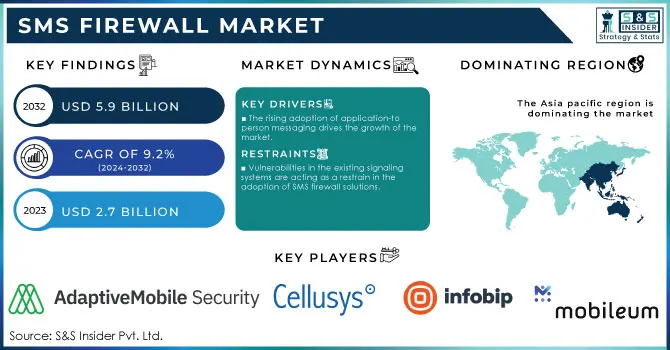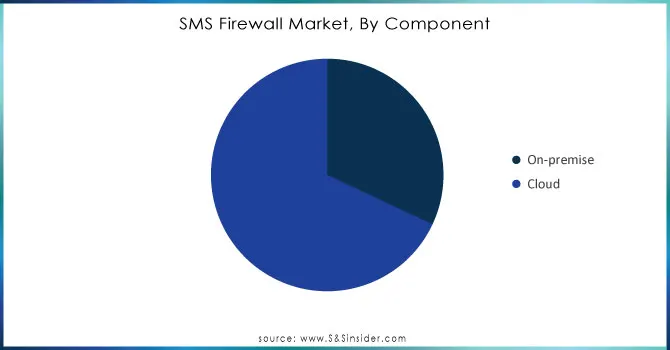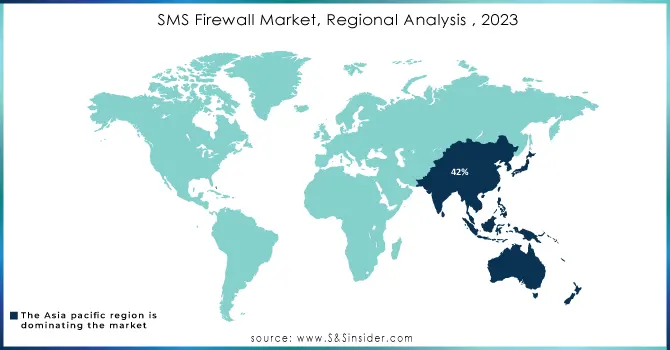SMS Firewall Market Report Scope & Overview:

To Get More Information on SMS Firewall Market - Request Sample Report
The SMS Firewall Market Size was valued at USD 2.7 Billion in 2023. It is expected to grow to USD 5.9 Billion by 2032 and grow at a CAGR of 9.2% over the forecast period of 2024-2032.
Increasing mobile messaging traffic is one of the significant factors boosting demand for SMS firewalls, which in turn drives the growth of the global SMS firewall market. As the number of mobile marketing campaigns, two-factor authentication processes, and social media verification only continues to overwhelm enterprises, they have never generated so many SMS messages before. This increasing reliance on SMS as the messaging mechanism for important communications raises an obvious need for spam and fraud protection. For this reason, more and more enterprises are implementing SMS firewalls to control traffic flows and protect their messaging ecosystem against spam or maliciously intended messages while keeping private or sensitive data safe. According to the International Telecommunication Union (ITU), global mobile subscriptions reached approximately 8.4 billion in 2023, reflecting a substantial increase in mobile device usage, which directly contributes to higher SMS traffic.
The increasing need for revenue assurance to prevent revenue losses from fraudulent activities is one of the key drivers driving the SMS firewall industry. Organizations understand the importance of protecting messaging services since SMS-based frauds, such as phishing and smishing, have become more prevalent. An essential tool for tracking and filtering traffic to stop fraudulent content from getting to customers is a well-designed SMS firewall. These solutions are crucial in today's digital world because they not only preserve the quality of SMS services and guard against fraud-related income loss for businesses, but they also foster client trust.
The U.S. Cybersecurity and Infrastructure Security Agency projects that cybersecurity spending will exceed USD 100 billion annually by 2025, highlighting the prioritization of security measures. Effective SMS firewalls serve as essential tools for monitoring and filtering traffic, ensuring that only legitimate messages reach consumers.
SMS Firewall Market Dynamics
Drivers
-
The rising adoption of application-to-person messaging drives the growth of the market.
-
The increase in security and privacy in SMSs is a major driver of the SMS firewall market
-
Technological advancements in the SMS firewall market, such as the use of artificial intelligence and machine learning, are driving the growth of the market
Major growth in the SMS firewall market is driven by technologically advanced products, especially telecom SMS firewall solutions integrated with artificial intelligence (AI) and machine learning (ML), as they can detect false alarms caused due to spam messages thus enabling faster detection. Powerful AI and ML make it possible for these systems to process millions of messaging data in real-time, quickly analyzing them detect patterns or anomalies that bring about threat behaviors such as spam messages and scam messages. By taking a proactive stance on threat detection and response, it offers better accuracy for blocking detected threats, while minimizing false positives and making sure that not block legitimate messages by mistake. With the constant evolution of cyber threats, organizations are turning to these advanced solutions for SMS security and integrity as it is vital for safeguarding revenue and customer trust.
U.S. Department of Justice (DOJ) Cybersecurity Initiatives reported in 2023 that it invested USD 70 million in cybersecurity initiatives, which include enhancing protections for SMS and messaging systems used by government entities and critical infrastructure sectors, further underscoring the government's focus on advanced security technologies.
Moreover, many companies launched new AI security for safety purposes such as, in 2023, IBM announced the launch of its AI-driven cybersecurity suite, which includes enhanced SMS firewall capabilities that leverage machine learning to detect and mitigate messaging threats more effectively.
Restraint
-
Vulnerabilities in the existing signaling systems are acting as a restrain in the adoption of SMS firewall solutions.
Current signalling systems, most importantly the SS7 (Signalling System 7) protocol, have weaknesses which serve as a constraint to SMS firewall solutions. SS7 provides interoperability between networks and features essential to mobile services, but its open nature and lack of security have made it vulnerable to various attacks, including interception, fraud, and spoofing. Cybercriminals can take advantage of these flaws to intercept personal information, wreak havoc on message traffic and conduct denial-of-service attacks. This could lead businesses to delay action to deploy SMS firewall solutions due to the inability of basic signaling system fortifications needed for overall defenses.
SMS Firewall Market Segmentation Overview
By Component
The SMS firewall platform segment held the largest market share of around 69% in 2023. SMS firewall solutions are growing quickly because of their advantages, which include real-time fraud protection, SMS income monetization, and grey route SMS identification and prevention. A Brazilian telecommunication company, TIM Brasil, saw monthly A2P SMS revenues double in just one quarter, once a next-generation SMS firewall was implemented. Six months or more after deployment, the mobile operator saw a revenue uplift of over 250%. Such a significant growth underscores the potential of next-generation SMS firewalls in creating revenue streams for TIM Brasil.
By SMS Type
In 2023, the A2P messaging segment accounted for the largest revenue share of over 76.1%. It is because it plays a key role in communications that occur between business and consumer. Applications that are crucial to providing outstanding customer service and managing your business fall under this category, including 2FA, transaction notifications, promotional messages, and appointment reminders. Its messaging has also been fueled by the growing use of real-time communication and mobile commerce in industries including retail, banking, and healthcare.
By Deployment
The cloud segment held the largest market share around 68% in 2023. The deployment of cloud-based firewalls is simple, it takes much less time than the installation of a traditional firewall. This enhanced system deployment ensures that the operation of businesses faces minimal intrusion. Moreover, cloud-based firewalls have lower maintenance and upgrade costs, since they require less manual intervention.

Do You Need any Customization Research on SMS Firewall Market - Enquire Now
SMS Firewall Market Regional Analysis
Asia pacific held the largest market share around 42% in 2023. The Asia-Pacific region is a rapidly growing market for mobile technology and communication. With a large and diverse population, increasing smartphone adoption, and expanding mobile networks, the APAC region presents significant opportunities for SMS firewall providers. The region's mobile-first approach to communication makes SMS an essential tool for personal and business interactions. Developing economies in the APAC region are experiencing significant growth in digital services, creating a need for robust security solutions to protect users from SMS-based threats. Regulatory variations across different countries in the region impact the adoption of SMS firewall solutions, as compliance with local regulations is crucial.
North America is expected to witness significant growth during the forecast period. The SMS firewall market in North America is driven by the high penetration of smartphones, the widespread use of SMS for communication, and the need for robust cybersecurity solutions. The region is home to several major telecom operators and technology companies that provide SMS firewall solutions.

Key Players in SMS Firewall Market
-
AdaptiveMobile Security (A2P SMS Firewall)
-
BICS (SMS Firewall Solution)
-
Cellusys (Cellusys SMS Firewall)
-
Comviva (Mobility Services Platform)
-
Infobip Ltd. (Infobip SMS Firewall)
-
Mobileum (Mobileum SMS Firewall)
-
Monty Mobile (Monty SMS Firewall)
-
Proofpoint (Proofpoint SMS Security)
-
Sinch (Sinch A2P Messaging)
-
TATA Communications (TATA SMS Firewall)
-
Twilio (Twilio Programmable Messaging)
-
Nexmo (Vonage) (Nexmo SMS API)
-
CloudMark (CloudMark Messaging Security)
-
Fortinet (FortiGate SMS Firewall)
-
Symantec (Symantec Messaging Gateway)
-
OpenMarket (OpenMarket SMS Messaging)
-
Viber (Viber Business Messages)
-
Amdocs (Amdocs Messaging Solutions)
-
Zenvia (Zenvia SMS Messaging)
-
MessageBird (MessageBird SMS API)
Key User
-
Verizon
-
Bank of America
-
Amazon
-
Cleveland Clinic
-
Walmart
-
Expedia
-
U.S. Department of Defense
-
Allianz
-
FedEx
-
University of California
-
AT&T
Recent Development:
-
In 2023 Adaptive Mobile Security declared that it had acquired Message Bird, a company that offered WhatsApp and SMS messaging services. Through this acquisition, Adaptive Mobile Security will be able to provide its clients with a more complete range of messaging solutions and enhance its SMS firewall capabilities.
-
In 2023, BICS Protect, a brand-new SMS firewall solution, was introduced. BICS Protect is intended to shield companies from a range of SMS-based dangers, such as fraud, phishing, and spam.
SMS Firewall Market Report Scope:
| Report Attributes | Details |
| Market Size in 2022 | US$ 2.7 Billion |
| Market Size by 2032 | US$ 5.9 Billion |
| CAGR | CAGR of 9.2% From 2023 to 2032 |
| Base Year | 2022 |
| Forecast Period | 2023-2032 |
| Historical Data | 2020-2022 |
| Report Scope & Coverage | Market Size, Segments Analysis, Competitive Landscape, Regional Analysis, DROC & SWOT Analysis, Forecast Outlook |
| Key Segments | • By Component (Platform, Services) • By SMS Type (Application-to-Person messages, Person-to-Application messages) • By SMS Traffic (National SMS traffic, International SMS traffic) |
| Regional Analysis/Coverage | North America (US, Canada, Mexico), Europe (Eastern Europe [Poland, Romania, Hungary, Turkey, Rest of Eastern Europe] Western Europe] Germany, France, UK, Italy, Spain, Netherlands, Switzerland, Austria, Rest of Western Europe]). Asia Pacific (China, India, Japan, South Korea, Vietnam, Singapore, Australia, Rest of Asia Pacific), Middle East & Africa (Middle East [UAE, Egypt, Saudi Arabia, Qatar, Rest of Middle East], Africa [Nigeria, South Africa, Rest of Africa], Latin America (Brazil, Argentina, Colombia Rest of Latin America) |
| Company Profiles | AdaptiveMobile Security, BICS, Cellusys, Comviva, Infobip Ltd., Mobileum, Monty Mobile, Proofpoint, Sinch, and TATA Communications |
| Key Drivers | • The rising adoption of application-to-person messaging drives the growth of the market. • The increase in security and privacy in SMSs is a major driver of the SMS firewall market • Technological advancements in the SMS firewall market, such as the use of artificial intelligence and machine learning, are driving the growth of the market |
| Market Restraints | • Vulnerabilities in the existing signaling systems are acting as a restrain in the adoption of SMS firewall solutions |

